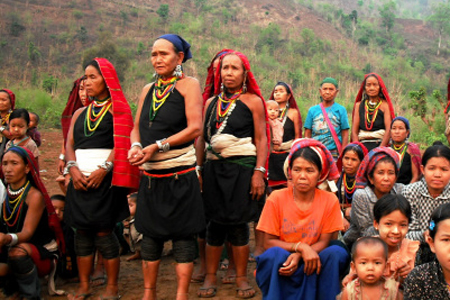February is one of the most bustling and crowded months in Myanmar when tourists all over the world make their plan to visit Myanmar and take part in regional festivals. If you are planning for a Myanmar tour with wonderful time soaking into the vibrant and colorful festival. Have a look at the list of Myanmar festival in February below.
Shwe Mann Settaw Pagoda Festival
Time: From the 5th day of Tabodwe month
Duration: 11 days
Location: Shwe Settaw, Magwe State, Central Myanmar
Meaning: It is held for pilgrims participate in merit-making rituals and worship the Buddhist shrine which keeps a pair of golden footprints.
This is the area with two temples offering Buddhist footprint, located on the waterfront Mann. During the festival, the people usually create many bamboo huts for local people to have fun, swimming in the hot dry season of Myanmar.
The monks will lead prayer rituals for the thousands of participants that make the pilgrimage in colorfully adorned native costumes. In addition, two sides of Mann River’s bank are decorated by merchant stores selling handcrafted goods and delicacies.
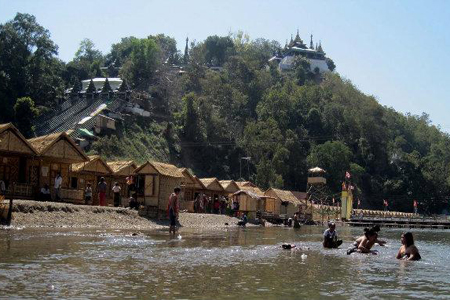
Kyaik Khauk Pagoda Festival
Time: From 8th to 15th day of the Tabodwe month
Duration: 8 days
Location: Thanlyin, near Yangon
Meaning: Kyaik Khauk Pagoda is considered as the harvest festival in Yangon.
This is one of the most famous temple festivals in Myanmar. Most of the activities at the festival take place in the evening with overnight performances and outdoor movies.
During the festivals, there are performances of traditional Burmese folk dancing and singing. Around the pagoda, merchant stalls selling traditional handicraft products of local people such as lacquerware, dishes, silk, garment, etc. Local people usually get to the pagoda by ox-carts. It ensure to bring up the authentic local taste so do not miss a chance to indungle in the festival while taking a day trip from Yangon,
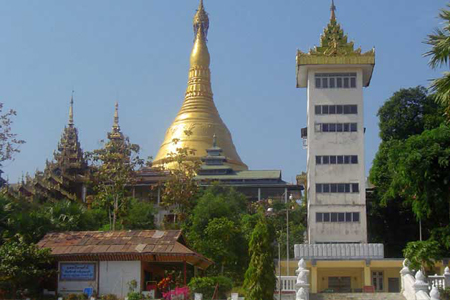
Mahamuni Pagoda Festival
Time: 14th and 15th of Tabodwe month
Duration: 2 days
Location: The ancient capital of Mandalay
According to legend, Mahamuni Buddha statue is made right in front of the Buddha, therefore the face of the Buddha statue is revered by pilgrims. The statue is gilded with 15 cm of gold. February is the coldest month in Myanmar, Mahamuni Pagoda organizes fire festival celebrating. People cook the sticky rice with ginger, coconut, and sesame to make offerings to the monks.
Monks perform reading of a Buddhist text. In the evening, there are various performances of traditional dances, music, and plays. Besides, a variety of incense sticks are burnt in the pagoda dedicated to the Buddha.
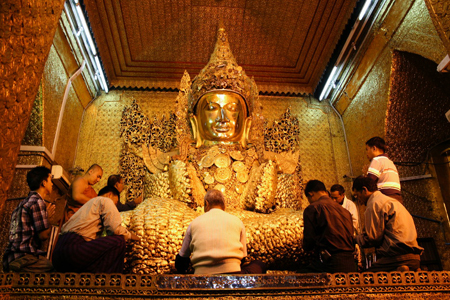
Htamane Sticky Rice Festival
Time: full moon day of Tabodwe month
Duration: 1 day
Location: Nationwide
The people cook sticky rice to make offerings to the Buddha in the morning of the 15th day of the month. Guests enjoyed watching performances, cook sticky rice competitions. And after offering rice ritual, sticky rice will be distributed to everyone. Finally, the winning team will receive the awards for winners.
Firstly, the sticky rice is dipped into the water overnight. The next day, start frying the small pieces of coconuts and other ingredients. Then pour in the soaked sticky rice into the pan. There are two strong men to stir the rice until it is cooked. Then Htamane is offered to the Buddha and is given away for free to all the visitors to the pagodas.
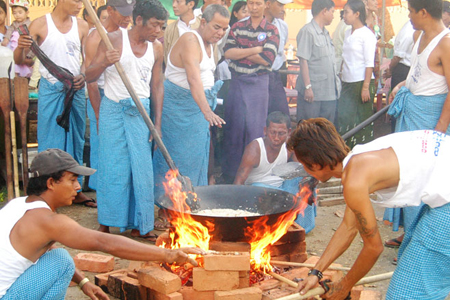
Moe Byae Festival
Time: 31st January - 3rd February 2015: Full moon day of Tabodwe
Duration: 4 days
Location: Moe-Byae, Shan State (a small town on the border of Shan and Kayah states)
This is the biggest festival in Shan State. The festival is outstanding with various shops selling everything from needles, candies to handcrafted products. Thousands of people mainly come from mountain tribes like Pao, Kayah, Shan and even a few Padaung from nearby mountain villages take part in religious rituals and enjoy traditional songs and dance performances.
